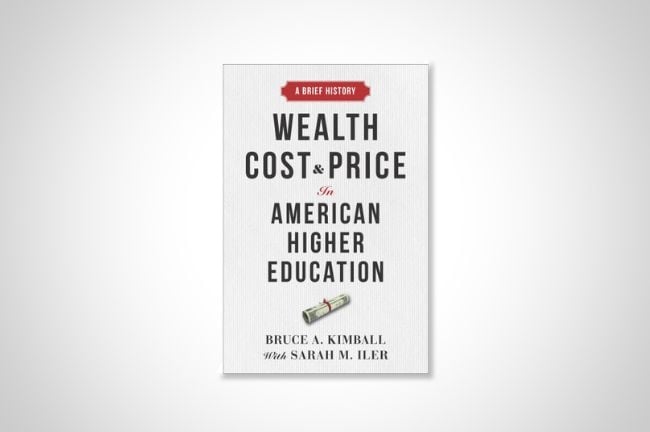You have /5 articles left.
Sign up for a free account or log in.

Johns Hopkins University Press
Wealth, Cost & Price in American Higher Education: A Brief History by Bruce A. Kimball, with Sarah M. Iler
Published in January 2023
The research and writing project rattling around in my head is about the future of the wealthy university. I wonder if it is possible to imagine elite higher education in 2050.
In a previous post, “Endowments 1990 to 2055,” I did some back-of-the-envelope calculations of the possible future wealth of today’s 60 wealthiest institutions. If my endowment projections are defensible (and I invite you to challenge my methodology and suggest alternatives), it would seem prudent to understand the implications of the current trajectory of institutional wealth for the broader postsecondary ecosystem.
Scholarship on the future of university wealth must begin with the past. Fortunately, Bruce Kimball (with Sarah Iler) has that scholarly ground well covered. Their book, Wealth, Cost & Price in American Higher Education: A Brief History, is indispensable and essential for anyone considering the wealthy university’s present and future.
Students of higher education interested in understanding the predicament of every institution across the postsecondary caste distribution will also benefit greatly from reading this book.
While the authors do not use this framing, one way to read Wealth, Cost & Price is as an answer to the following four questions:
- What historical roots underpin current ideas around university endowments, fundraising and spending?
- How did endowment wealth become so concentrated among a relatively small number of institutions?
- What explains the upward spiral of institution costs and student tuition prices (as well as student debt)?
- How might wealthy universities rethink their management and distribution endowment strategies?
If you are curious about the answers to these questions, then time reading Wealth, Cost & Price will provide an excellent ROI. The authors set about answering these questions (and many others) by investigating historical primary documents, discussing economic theories and analyzing institutional financial data.
Without going deeply into how all four questions above are addressed, several key themes surfaced in the book that will be essential for scholarship on the future of university wealth.
Perhaps most important in these themes is the belief, now universally shared across all institutions and academic leadership, that an endowment is essential for “autonomy, flexibility and stability.” These are attributes that a university can never have too much. And therefore, an endowment can never grow too large.
Another theme that runs through Wealth, Cost & Price is an analysis of how higher education has thought about the rising cost of our institutions and the rising prices our students pay. In the authors’ telling, our thinking about cost and price has been, at best, muddled.
For too long, we accepted (or maybe misunderstood) William Baumol and William Bowen’s cost-disease theory as the explanation for rising prices and student debt. Howard Bowen’s revenue-cost theory offers an alternative framework to understand the current state of postsecondary economics.
Perhaps most valuably, Wealth, Cost & Price discusses the generational and structural inequality that characterizes the higher education system. The authors point out that “In 2020, the wealthier 1 percent of colleges and universities owned 54 percent of the endowment of American higher education.” This wealth concentration among universities now nearly mirrors the U.S. household wealth distribution.
The book concludes with some sensible advice to wealthy schools about their responsibility to their stakeholders and communities. University leaders and trustees of institutions at every place in the academic caste system would be wise to absorb and discuss Wealth, Cost & Price.
For anyone curious about the future of the wealthy university, the book provides the ideal starting place for that line of inquiry.
What are you reading?




